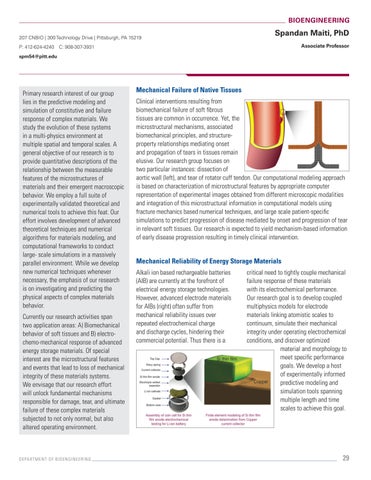BIOENGINEERING 207 CNBIO | 300 Technology Drive | Pittsburgh, PA 15219
Spandan Maiti, PhD Associate Professor
P: 412-624-4240 C: 908-307-3931 spm54@pitt.edu
Primary research interest of our group lies in the predictive modeling and simulation of constitutive and failure response of complex materials. We study the evolution of these systems in a multi-physics environment at multiple spatial and temporal scales. A general objective of our research is to provide quantitative descriptions of the relationship between the measurable features of the microstructures of materials and their emergent macroscopic behavior. We employ a full suite of experimentally validated theoretical and numerical tools to achieve this feat. Our effort involves development of advanced theoretical techniques and numerical algorithms for materials modeling, and computational frameworks to conduct large- scale simulations in a massively parallel environment. While we develop new numerical techniques whenever necessary, the emphasis of our research is on investigating and predicting the physical aspects of complex materials behavior. Currently our research activities span two application areas: A) Biomechanical behavior of soft tissues and B) electrochemo-mechanical response of advanced energy storage materials. Of special interest are the microstructural features and events that lead to loss of mechanical integrity of these materials systems. We envisage that our research effort will unlock fundamental mechanisms responsible for damage, tear, and ultimate failure of these complex materials subjected to not only normal, but also altered operating environment.
DEPARTMENT OF BIOENGINEERING
Mechanical Failure of Native Tissues Clinical interventions resulting from biomechanical failure of soft fibrous tissues are common in occurrence. Yet, the microstructural mechanisms, associated biomechanical principles, and structureproperty relationships mediating onset and propagation of tears in tissues remain elusive. Our research group focuses on two particular instances: dissection of aortic wall (left), and tear of rotator cuff tendon. Our computational modeling approach is based on characterization of microstructural features by appropriate computer representation of experimental images obtained from different microscopic modalities and integration of this microstructural information in computational models using fracture mechanics based numerical techniques, and large scale patient-specific simulations to predict progression of disease mediated by onset and progression of tear in relevant soft tissues. Our research is expected to yield mechanism-based information of early disease progression resulting in timely clinical intervention.
Mechanical Reliability of Energy Storage Materials Alkali ion based rechargeable batteries (AIB) are currently at the forefront of electrical energy storage technologies. However, advanced electrode materials for AIBs (right) often suffer from mechanical reliability issues over repeated electrochemical charge and discharge cycles, hindering their commercial potential. Thus there is a
critical need to tightly couple mechanical failure response of these materials with its electrochemical performance. Our research goal is to develop coupled multiphysics models for electrode materials linking atomistic scales to continuum, simulate their mechanical integrity under operating electrochemical conditions, and discover optimized material and morphology to meet specific performance goals. We develop a host of experimentally informed predictive modeling and simulation tools spanning multiple length and time scales to achieve this goal.
29





























































































